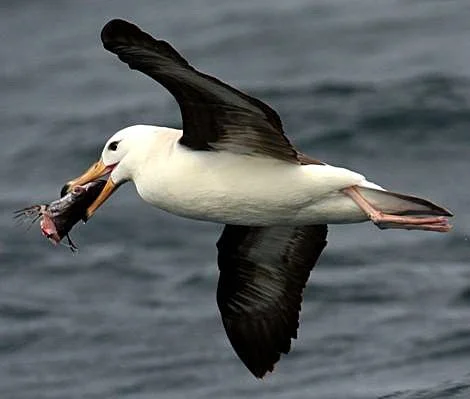South African trawlers reduce albatross deaths by 99 per cent
f217ec55-1238-4b82-9f7e-5715a5541c68

A single measure has almost eradicated seabird by-catch in South Africa's hake fisheries, bringing worldwide hope to conservationists.
Across the southern hemisphere, 17 of the world's 22 albatross species are suffering from radical declines, and the finger has been unanimously pointed at the practice of long line fishing, where baited hooks are strewn out for miles behind trawlers to catch large popular edible fish like tuna and dolphin. Seabirds, and particularly albatrosses, are attracted to the bait on the fishing lines or the offal produced as the fish are processed onboard, and become fatally trapped on the hooks.
Having been given Marine Stewardship Certification in 2004 to ensure that fish stocks remained healthy an viable, the hake trawl fishery assessed its seabird by-catch. Alarmingly, around 10,000 seabirds, many endangered, were being caught and killed accidentally – around 70 per cent of these were albatrosses. This is a substantial part of the global by-catch of about 300,000 seabirds, one third of which are albatrosses.
Now, a recent initiative in South Africa has been shown to stop this from happening almost entirely. Bird scaring lines, consisting of about 30 m of rope with five to 10 paired streamer lines of lighter material attached at 2 m-intervals, were attached to active trawlers. Along with drag provided by a road cone, the ropes were trailed behind boats parallel to the trawler's long lines, distracting and confusing the seabirds attracted to the trawlers, and largely keeping them at a safe distance. Previously, seabirds were scared off by the use of 'tori lines', which employed a similar method of attaching streamers to the long lines, or by weighting them so that they sank out of reach.
The data collected over the five years after the bird scaring lines were introduced (on the advice of BirdLife South Africa) has shown that overall seabird deaths were reduced by 90 per cent, while albatross deaths were almost entirely stopped, with a 99 per cent drop. The lines are already being used elsewhere, but this is the first time they have been shown to be so effective.
The lines were manufactured by BirdLife South Africa and the Ocean View Association for Persons with Disabilities, and ten such persons can make a finished line in about an hour.
Bronwyn Maree, Albatross Task Force Manager for BirdLife South Africa, said: "We've worked closely with this fishery since the early 2000s to demonstrate that avoiding seabird by-catch is good for business and for the environment. Moreover, it's relatively easy given the right tools. Bird scaring lines have now become part of everyday life at sea and fishermen no longer resist their use."
"This fishery should be commended on their approach and support which enabled such huge successes to be achieved in a relatively short period of time," said Martin Purves of the Marine Stewardship Council.
Across the southern hemisphere, 17 of the world's 22 albatross species are suffering from radical declines, and the finger has been unanimously pointed at the practice of long line fishing, where baited hooks are strewn out for miles behind trawlers to catch large popular edible fish like tuna and dolphin. Seabirds, and particularly albatrosses, are attracted to the bait on the fishing lines or the offal produced as the fish are processed onboard, and become fatally trapped on the hooks.
Having been given Marine Stewardship Certification in 2004 to ensure that fish stocks remained healthy an viable, the hake trawl fishery assessed its seabird by-catch. Alarmingly, around 10,000 seabirds, many endangered, were being caught and killed accidentally – around 70 per cent of these were albatrosses. This is a substantial part of the global by-catch of about 300,000 seabirds, one third of which are albatrosses.
Now, a recent initiative in South Africa has been shown to stop this from happening almost entirely. Bird scaring lines, consisting of about 30 m of rope with five to 10 paired streamer lines of lighter material attached at 2 m-intervals, were attached to active trawlers. Along with drag provided by a road cone, the ropes were trailed behind boats parallel to the trawler's long lines, distracting and confusing the seabirds attracted to the trawlers, and largely keeping them at a safe distance. Previously, seabirds were scared off by the use of 'tori lines', which employed a similar method of attaching streamers to the long lines, or by weighting them so that they sank out of reach.
 |
| A hake trawler with thousands of birds in attendance; an orange buoy and bird scaring lines are visible off the stern of the vessel. Photo: Ross Wanless. |
The data collected over the five years after the bird scaring lines were introduced (on the advice of BirdLife South Africa) has shown that overall seabird deaths were reduced by 90 per cent, while albatross deaths were almost entirely stopped, with a 99 per cent drop. The lines are already being used elsewhere, but this is the first time they have been shown to be so effective.
The lines were manufactured by BirdLife South Africa and the Ocean View Association for Persons with Disabilities, and ten such persons can make a finished line in about an hour.
Bronwyn Maree, Albatross Task Force Manager for BirdLife South Africa, said: "We've worked closely with this fishery since the early 2000s to demonstrate that avoiding seabird by-catch is good for business and for the environment. Moreover, it's relatively easy given the right tools. Bird scaring lines have now become part of everyday life at sea and fishermen no longer resist their use."
"This fishery should be commended on their approach and support which enabled such huge successes to be achieved in a relatively short period of time," said Martin Purves of the Marine Stewardship Council.

